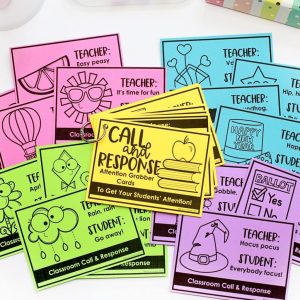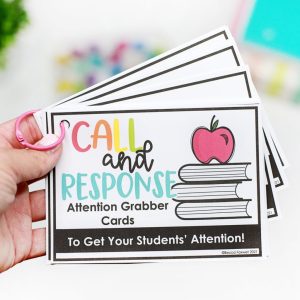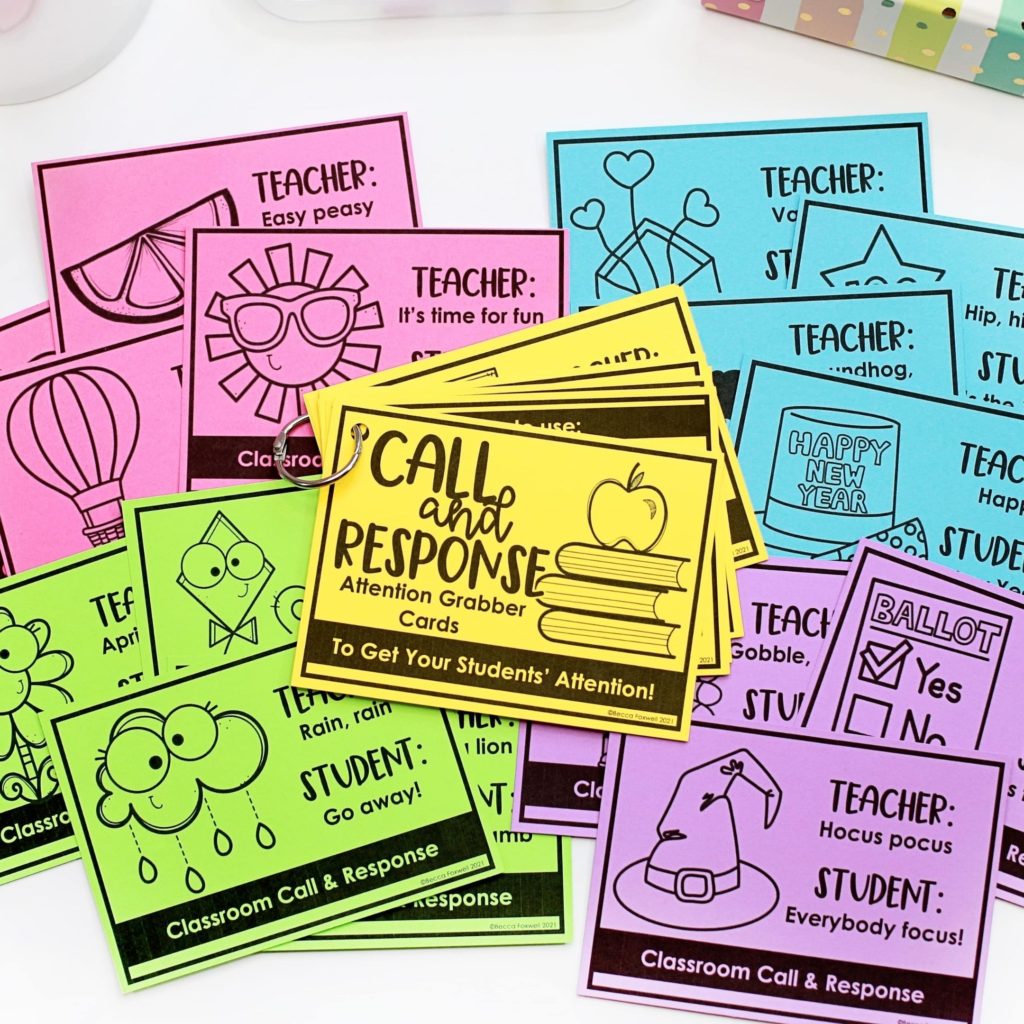Student Contributor: C Parkhurst
 A fun and efficient way of gathering your class’ attention without yelling. Using specific phrases that require a call back from students that signal it is time to focus on the teacher.
A fun and efficient way of gathering your class’ attention without yelling. Using specific phrases that require a call back from students that signal it is time to focus on the teacher.
This tool should be used before direct instruction from the teacher or whenever whole group attention is needed. There are several different cards that students will receive with the call out and call back response listed. The teacher will call a phrase out, for example “Hocus pocus” and students would respond with “Everybody focus.” My fifth grade teacher used these and I remember always calling back the response and effectively stopping what I was doing and turning my attention to my teacher. This teaches students that attention can be brought in a different way then yelling, helping teachers demonstrate proper behavior.
 This tool can be used in the preventative stage. The preventative stage is about preventing issues before the arise, in this case gathering an entire class attention without yelling. It often takes a while to gather attention, especially in younger grades, and this tool gives the teacher direct feedback as to who is focus and who is not. I think this tool fits both the teacher directed and collaborative and the collaborative theories best. This is a collaborative tool, as it takes both the teacher and student to use the tool effectively. However, their choices are limited as it is the teacher who calls out first. Along with that theory, this belongs in the collaborative and teacher directed due to the fact that it is for the attention of students, but is directed by the teacher which the attention falls to. The tool desires student involvement while still personally maintaining control to the teacher.
This tool can be used in the preventative stage. The preventative stage is about preventing issues before the arise, in this case gathering an entire class attention without yelling. It often takes a while to gather attention, especially in younger grades, and this tool gives the teacher direct feedback as to who is focus and who is not. I think this tool fits both the teacher directed and collaborative and the collaborative theories best. This is a collaborative tool, as it takes both the teacher and student to use the tool effectively. However, their choices are limited as it is the teacher who calls out first. Along with that theory, this belongs in the collaborative and teacher directed due to the fact that it is for the attention of students, but is directed by the teacher which the attention falls to. The tool desires student involvement while still personally maintaining control to the teacher.
More Information –
Tool Source: Foxwellforest.com



Grade Level: 4th
Number of Students: 26
Suburban
This tool is very easy to prepare for because all you need is a white board and a white board marker. The teacher selected three options each month and the students would select their favorite to use by a vote. I felt like it succeeded in creating and maintaining an engaging and responsive environment for all of the students. The students when using this tool are very quick to get back on track or give attention back to the teachers. If I was to suggest any changes, I would encourage you to add some kind of movement action with the response part of this tool or maybe add some kind of music element.
3rd Grade
15 students
Suburban
I didn’t realize how many of these there actually were! I thought my mentor teacher just came up with his on his own, but it turns out that call and response, was on one of the lists I saw. I asked the students if I could try a few call and response cues that week. One per each day I was there and I was there for a total of three days. I wanted to do it this way for a couple reasons. One, was that I wanted to see if I liked it. I knew I couldn’t use it just one or two times and decide. However, I did not want to confuse the students either. That’s why I asked them if it was OK. Once I had their OK to use the 1st call and return for a full day, then change it for 2nd day, then the 3rd , I did. Surprisingly, it went really well. I didn’t think it would, because I thought they were already used to me. However, I think because it was my own, not my mentor’s it got their attention quicker. I picked out “Watch Me Whip…..Watch Me Nae Nae”, “I’m The Queen….Of The World”, and “Ready To Rock….Ready To Roll” They thought that it was hilarious, because I used ones they had never heard of. Then I thought it was hilarious that they thought it was so funny. We had fun trying them. I honestly don’t know what I could do that would make this any better. Although, I can let the students write down a couple and then they can vote on one I can use the very next week.
Call and Response:
Gade level- 1st grade
Number of students- 21 Students
Urban, suburban, or rural- Suburban/rural
The class and response tool is a great management tool to help students focus and listen to the speaker. This tool was pretty easy to prepare because there are many resources for different phrases, I would suggest finding an engaging and fun one for your class. This was also fairly easy to teach just make sure you practice a couple of times before using it. Using this tool was successful. When calling out “Scooby Dooby Doo where are you?” students responded, “We have some work to do now.” My students really enjoyed this phrase because it was at their interest level. After using this phrase students understood they should respond, stand still, have their voices off, and their eyes on me. One adjustment I would consider for this using different tones/voices when calling out your phrase and having your students respond using the same tone/voice as you. Adding this adjustment would make this tool more fun and engaging for your students.
This is a fun tool to use because it can be personalized to your classroom environment and what you believe the students would enjoy calling out. I personally used the call “hey class” and then my students respond with “hey what?” and then I say “hey class” again, and they respond with “hey what hey what?”. This call to attention is fun because it incorporates some kind of rhythymic response that is like a song. My suburban 5th grade class responded very well to this. The school is a very musically centered school so it fit well. The only thing I recommend is making sure that you consistently wait and do the call again if there are students who are not listening, and wait until you have the whole class’ attention, so that you assert to the students that you are serious when you do the call and they understand that it means focus even if its done in a fun way.
Grade: 1st
Number of Students: 16
Suburban
This tool is great to use to grasp students’ attention while having a bit of fun. In my practicum, we based our call and response on what they were learning that month or week. These past couple of months the students have been learning about birds, their features, and how to take care of them. For that topic, the teacher would do a bird call and the students respond back with that exact same bird call. Another one they had was for just general gathering attention. One of them was when the teacher said “Classity, class” the students would say “Yessity, yes.” Another call and response we practiced was the teacher said “One, two, three eyes on me” and the students say “One, two eyes on you”. Call and response reset students’ minds to what they need to focus on next, and also can be enjoyable for even teachers too!